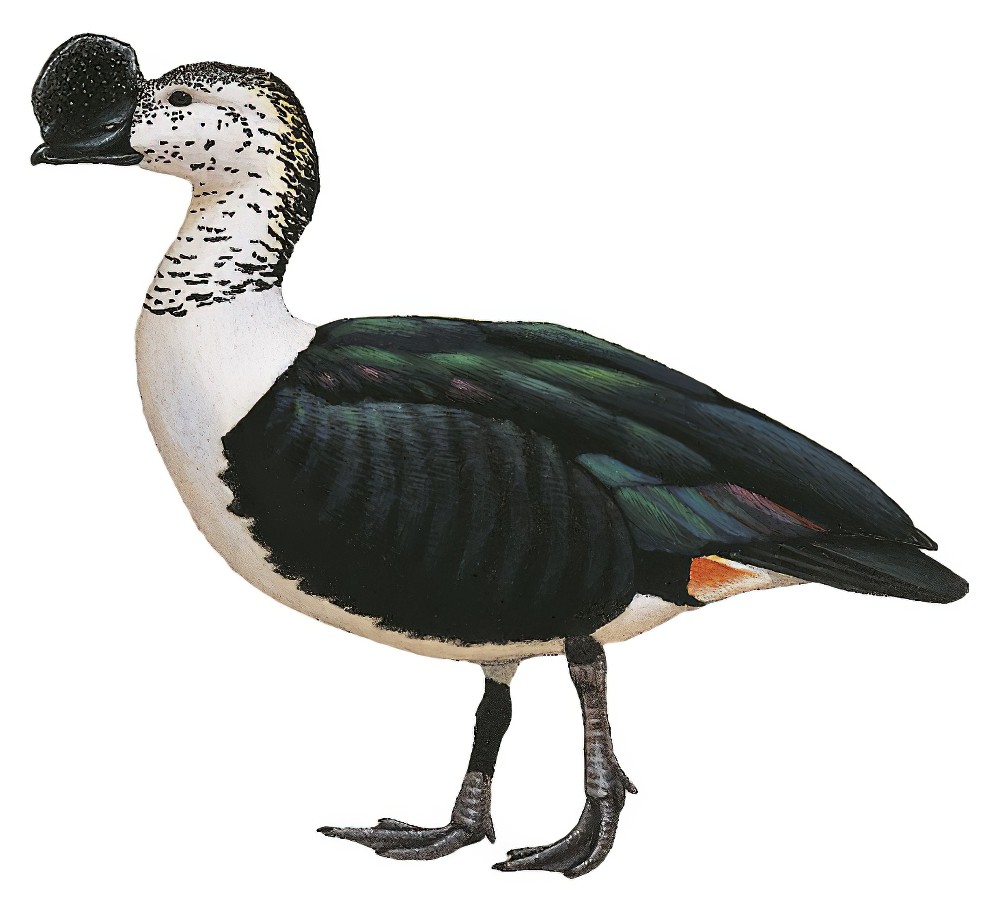Comb Duck / Sarkidiornis sylvicola

Comb Duck
SCI Name:
Protonym: Sarkidiornis sylvicola Cat.FaunaBrazil. 1 p.72,408
Taxonomy: Anseriformes / Anatidae / Sarkidiornis
Taxonomy Code: comduc3
Type Locality: Iguape, Sao Paulo, Brazil, and Buenos Aires, Argentina.
Author: von Ihering, H & von Ihering, R
Publish Year: 1907
IUCN Status: Least Concern
DEFINITIONS
SARKIDIORNIS
(Anatidae; Ϯ African Comb Duck S. melanotos) Gr. σαρκιδιον sarkidion small piece of flesh < dim. σαρξ sarx, σαρκος sarkos flesh; ορνις ornis, ορνιθος ornithos bird; "GENUS VII. SARKIDIORNIS. EXT. CHAR. Pedes digitis posterioribus mediocribus, in tarsis alte locatis. Tarsi mediocres. Rostrum in maribus caruncula magna compressa culmine. Nares rotundatæ magnæ. Alæ una calcaria armatæ, et remigibus apices versus incurvatis. Cauda ad apicem truncata. ... TYPE. Sarkidiornis melanotus. Various have been the genera in which the bird before us has been placed (Anser melanotus, Linn.), with none of which does it agree. We have therefore proposed a new one for it. Affinities. We have placed it, as far as we have been able (no anatomical character being known), in what appears to us to be its proper place, namely between the genera Chenalopex and Anser. It agrees with the former, in having a spur on the wing." (Eyton 1838).
Var. Sarcidiornis, Sarkidornis.
sylvicola
L. silvicola inhabiting woods, sylvan < silva woodland, forest; -cola -dweller < colere to inhabit.
● ex “Ynambú listado” of de Azara 1802-1805, no. 331 (syn. Crypturellus undulatus).
Sylvicola
L. silvicola inhabiting woods, sylvan < silva woodland; -cola -inhabitant < colere to inhabit.
• (Columbidae; syn. Columba † Yellow-eyed Pigeon C. eversmanni) "I rod'. Columba L. A) Rupicola. 1. Columba livia Briss. (C. neglecta Sewerzow). ... 2. Columba rupestris Pall. B) Sylvicola. 3. Columba fusca Pall. (C. Eversmanni Bp. = C. fusca, β brachyura Sew.). 4. Columba œnas Briss." (Bogdanov 1881) (OD per Laurent Raty).
• (Phylloscopidae; syn. Phylloscopus † Wood Warbler P. sibilatrix) "GENUS 10. SYLVICOLA. Nobis. Sp. 1. S. TROCHILUS. Linnæus. ... Sp. 2. S. SIBILATRIX. Bechstein. ... Sp. 3. S. RUFA. Latham." (Eyton 1836); "Sylvicola Eyton, 1836, Cat. British Birds, p. 13. Type, by tautonymy and subsequent designation (G. Gray, 1855, Cat. Genera Subgenera Birds Brit. Mus., p. 34), Sylvia sylvicola Montagu, 1798 = Motacilla sibilatrix Bechstein, 1793." (JAJ 2021).
• (Parulidae; syn. Setophaga † Northern Parula S. americana) "G. SYLVICOLA. Swains. in Zool. Journ. No. 10. 38. Sylvicola pusilla. Wilson iv. pl. 28. f.1. 39. Sylvicola Blackburnia. Wilson iii. pl. 23. f. 3. 40. ——— citrinella. Wilson ii. pl. 15. f. 5. 41. ——— flavicollis. Wilson ii. pl. 13. f. 6. 41. ——— inornata. ... This, and all the foregoing species, were collected near Vera Ceuz, and seem to be young birds." (Swainson 1827 (Philos. Mag.)); "SYLVICOLA. ... Type. Sylvia pusilla. Wilson, 4. pl. 28. f. 3. This genus, which will comprise exclusively the greatest part of the Sylviæ of North America, is strictly typical. The formation of the wing affords an unerring mark of distinction. The nearest approach I have yet seen towards this extensive group is made by another, which has just been characterized by Mr. Vigors and Dr. Horsfield, under the name of Zosterops" (Swainson 1827 (Zool. Journ.)); "Sylvicola (not of M. Harris, 1776) Swainson, Phil. Mag., (n. s.), 1, No. 6, p. 433, June, 1827—type, by subs. desig. (Swainson, Zool. Journ., 3, No. 10, p. 169, Sept., 1827), Sylvia pusilla Wilson [= Parus americanus Linnaeus]." (Hellmayr, 1935, Cat. Birds Americas, Pt. VIII, p. 347).
Var. Silvicula.
• (Parulidae; syn. Setophaga † Myrtle Warbler S. coronata) "SYLVICOLA, Swains. (1827). Ficedula, (Briss.) Cuv. (1799-1800). Sylvia, Lath. Curruca, Less. Motacilla, Gm. Regulus, p. Cuv. (1817). Phyllopneuste, (Meyer) 2nd div. Boie. S. coronata, (L.) Swains. Edw. t. 255." (G. Gray 1841); "Sylvicola "Swainson" G. Gray, 1841, List Genera Birds, 2nd ed., p. 32. Type, by original designation, S. coronata, i.e. Motacilla coronata Linnaeus, 1766." (JAJ 2021).
UPPERCASE: current genus
Uppercase first letter: generic synonym
● and ● See: generic homonyms
lowercase: species and subspecies
●: early names, variants, mispellings
‡: extinct
†: type species
Gr.: ancient Greek
L.: Latin
<: derived from
syn: synonym of
/: separates historical and modern geographic names
ex: based on
TL: type locality
OD: original diagnosis (genus) or original description (species)












